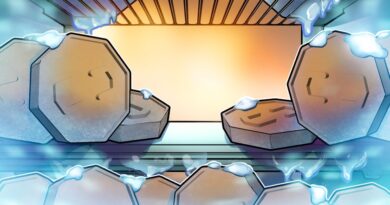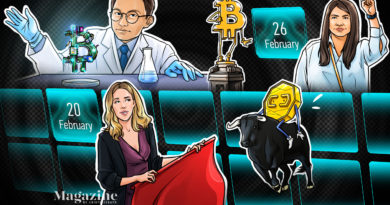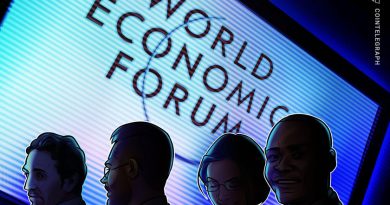Storming the ‘last bastion’: Angst and anger as NFTs claim high-culture status
Its as immutable as a transaction on the blockchain: Nonfungible tokens, or NFTs, have permanently made their mark on art history. While the movement has some members of the arterati swooning at the notion of unwashed digital hordes laying siege to their domain, the reality is that the two worlds of high art and crypto are fated to become one and the same.
You might not have heard of Mike Winkelmann, but at least one art icon is ready to say he could rank up there with Pablo Picasso. The 39-year-old artist better known as Beeple has successfully forced his way into over a half-dozen different encyclopedia entries today after the sale of a career retrospective collage, The First 5000 Days, was auctioned off in the form of an NFT for a staggering $69.3 million.
holy fuck.
— beeple (@beeple) March 11, 2021
The sale set numerous records and earned Winkelmann a number of highfalutin superlatives ones that are no doubt making NFT collectors and prospectors rub their palms: the third-most expensive piece sold at auction by a living artist, the first wholly digital NFT sale at Christies and the most expensive NFT ever sold.
Aside from bumping up the cap on multiple biggest-ever records, the $69 million price tag also marks a definitive point of no return. If there was an opportunity to wrangle the narrative, to alter the trajectory of the zeitgeist, it has long past. Beeple is now an artist of worldwide historical importance; Beeple is high culture. Beeple sold his work as an NFT; NFTs are the new medium of high art. The debate is over, and were merely left to wonder and worry over what it all means.
As Kenny Schachter, a self-described writer-artist-curator-teacher-dealer,” told Cointelegraph:
Whether the fine art world likes it or not, this IS the fine art world now […] These are the people [that] are going to revolutionize the business they already have and change how people collect and what people collect. Its already happened.
The great irony, of course, is that the fine art world and the cryptocurrency world have more in common than not. While the gatekeepers of high art rush to defend what Schachter calls the last bastion of expression that hasnt been exploited by the media from corrupting NFT incursions, the existing NFT culture, ethos and tech might be how the last bastion maintains its elite status for generations to come.
Scare quotes abound
Beeple is one of the largest natively digital artists and Christie’s one of the largest traditional auction houses, said Aaron Wright, co-founder of OpenLaw and the NFT investment group Flamingo DAO, of the auction. NFTs are no longer operating at the margin. They are moving to the heart of the art world.
Its a shift that not even longtime participants in the NFT space, such as collector and developer Nate Hart, have fully come to terms with. Just two years ago, Hart was attending hackathons and shipping indie NFT projects; now, hes being interviewed on nationally syndicated news programs about his collection.
The Beeple thing is pretty crazy to me. It doesn’t strike me as something that would be placed among high art, but I have long expected some of the most elite NFTs like CryptoKitties #1 and/or CryptoPunk aliens would be in Christie’s or Sotheby’s eventually, said Hart. I have several NFTs that are worth 6 figures now and I wonder to myself, Am I a high-end art collector now?
That exact question has the established high-end dealers, collectors, gallerists and other art world banner carriers breaking into fits of apoplexy. Theres been a spate of grumblings disguised as think pieces from members of the art world both high and low: Georgina Adam broke out scare quotes while arguing that most established art world participants would be horrified by most of the art offered as NFTs; Brian Droitcour decried the majority of the listings on SuperRare as derivative dross and said that the wider crypto space is fundamentally pyramidal in nature; and prior to recanting some of his statements as stupid in an interview with Cointelegraph, Schachter combined Adams and Droitcours views, saying A lot of NFT art doesnt communicate much, nor have anything in the way of purpose other than its exchange value.
Art critic Blake Gopnik made his view especially clear in his interview with Marketplace:
No one, I hope, no one is saying these are timeless works of human creation and ingenuity, because theyre just completely trivial as artworks.
Adding on top of these qualitative arguments, anti-riot gear has recently been distributed to arterati gatekeepers in the form of accusations regarding the calamitous environmental impact of NFTs a tired old Gish gallop that the wider cryptocurrency world has been fending off for a decade-plus. The thing is, crypto can keep fending: Outsiders wildly underestimate the delight nerds take in composing rebuttal blogs.
— Moxarra Gonzalez (@Moxarra) March 10, 2021
If digital currency aficionados feel like theyve heard all this before, its because they have Itll be blockchain, not Bitcoin Its a fun experiment, but theres no staying power It’s a pyramid scheme; the only value comes from greater fools. There are a few slight twists in terminology and use case (art instead of currency), but ultimately, its the same cocktail of long-debunked FUD.
Strange My Bed–fellows
Likewise, art world participants with a greater sense of nuance (or in possession of a financial incentive to welcome a new trend, take your pick) also spot cyclicality in these arguments from critics.
Noah Davis, a specialist in Post-War and Contemporary art at Christies who oversaw the Beeple auction, told Cointelegraph that the pearl-clutching response is not unlike the advent of Street Art as a blue chip collecting category, where the controversy surrounding the work of outsider artists like Banksy entering auction houses paradoxically legitimized the work.
A similar view comes from Damien Hirst, the iconic British artist who recently said he loved cryptocurrency and would be accepting it for a print run. When Hirst and the other Young British Artists forced their way onto the scene in the late 80s, critics launched similarly predictable, scare-quote heavy tirades, going so far as to write whole books about why Hirsts work was a sham. Today, hes one of the highest-grossing artists at auction ever.
Hirst told Cointelegraph that the critical dustup is a rodeo hes attended at least once before:
I havent heard a good argument yet for why this new crypto art isnt art and thats how it always starts, theres not really any doubt that Beeple, (Mike Winkelmann) is a fucking great artist and why not on a par with any of the great artists of history? I love it when something comes along that makes the small minded artworld get its knickers in a twist and mostly when that shit happens in my experience its not going away anytime soon.
The centimillionaire also teased an NFT project of his own, The Currency, which is set for release later this year a drop that will make him comfortably the highest-profile institutional artist to make the leap into the NFT art world.
Ideology, art and technology
Part of whats making the arterati so fussy is that NFTs as an art movement resist simple historical contextualization. Its not quite a semi-homogenous aesthetic trend like Pop art or Post-Internet, nor is it just a technological advancement like photography and it cant be easily lumped into an ideological movement like the Situationists or Dadaism. Its a loose, dynamic blend of ideology, art and technology. But despite the ever-shifting landscape, the critics sought and found in that slurry the necessary ingredients to set themselves dyspeptic.
In contrast, participants within the young movement are notably optimistic. NFT collector gmoney breaks down three key technical innovations:
I think there are a few things that are making blockchain art stand out as a movement. First is the artist being able to more directly interact with their collectors. Second, is the provable provenance of work, and the ability to get paid for that work. And third, is the 24/7 international market that is always open.
Combine those properties enabled by the blockchain with a free, open-source ethos and an aesthetic that tends toward a flashy and a more-is-more attitude, for better or for worse, as Hart puts it, and you have the outline of something at least vaguely resembling a fully-fledged artistic movement.
Critics, however, point out that barring the blockchain-based technological advances everything the NFT art movement is bringing to the table has been done before. Droitcour says there were experiments in digital ownership with the net art of the 90s, and multiple observers have noted that NFT artists are largely deploying well-trod forms artists have experimented with since digital art first emerged in the 1960s.
These gripes aside, most critics just dont like NFT art. Reason being: NFT art doesnt know how to put the pinkie out.
Descriptors include garish, cartoonish and comparisons to something youd see on the back of a van. It needs a little bit more critical engagement. Theres a more-than-faintly paternalistic belief that NFT artists need to open a few history books and learn about art-art if they really want to make a lasting historical impact.
Gobbling tulips
Many of the above comments came from one critic in particular: Schachter. He, who describes himself as the most democratic person youll meet who has a position in the fine art world, has since walked at least some of them back, however, and now thinks that NFT art is primed for an institutional takeover.
All the people making fun of it are going to be putting it on their walls in 5-10 years, he told Cointelegraph.
Shachters about-face likely mirrors a conversion the rest of the art world is set to undergo. And how can they not? The crypto art market is rapidly approaching a half-billion dollars in sales, a growing percentage of the entire art market. If you want blockchain tech and blockchain new money, the existing cultural capital of blockchain art is a necessary stick.
The Ethers out of the ether, and nothings going to stuff it back in, said Schachter. There will be hyperinflation of prices with a few specific phenomena, but this is no way a bubble.
Wedding the two worlds will require a period of mutual education, however. Schachter is currently teaching a class at New York University on NFTs (it was set to be a history of furniture design, but the students demanded more timely material), doing a deep dive on the history of NFTs and NFT art.
He says he loves the anarchy, and the nihilism, I love the disruption of these people fucking the art world up and shaking it up, but he bemoans the lack of contextualization NFT artists have about their place in art history.
I tokenized my grandma @opensea pic.twitter.com/3NNZgEI0ck
— kenny schachter (@kennyschac) March 7, 2021
Some of these artists don’t know who, you know, who Calder is, Giacometti, or Miro, or even the most well-known artists, he said. […] These people are artists, I dont care if they know who Basquiat is or not, if anyone makes something thats a visual means of self expression, its all valid. But if you want it to be art or call it art, crack a book.
Its an onus he puts on himself, NFT artists and the fuddy-duddy art world all at once all parties need to learn each other’s history and to adapt to the new technological world.
Covid accelerated the boring, stupid art world relationship with technology and advanced it 15 years in one year, he said. Theres simply no going back.
To help bring the worlds together, Schachter is curating Breadcrumbs, a show of NFT art that will be displayed at German gallery Nagel Draxler on April 9. A preview reveals hell be showing off Cryptopunks and Pepes as part of the pieces on display:
Breadcrumbs an NFT art exhibit at @nageldraxler in Cologne opening April 9th. Artist list to follow… pic.twitter.com/MmHHC7HpIu
— kenny schachter (@kennyschac) March 10, 2021
If there are battle lines between the traditional art world and the NFT art world, its clear where Schachter stands (even if he has lobbed grenades in multiple directions). When asked about Breadcrumbs, the curatorial theme wasnt subtle:
Its about giving a fuck-you to the art world, that this is art whether you like it or not.
Citadel, meet bastion
Of the dozen criticisms Ive read, only one came close to getting it right.
In a piece for his publication, ARTnews president Marion Maneker portrayed the crypto hoards as barbarians, having successfully laid the financial doubters low and now roaming the lands for yet another city to raze a city that Maneker implies exists only in their imaginations.
Its not about the art. Its not even all about the money, he wrote. […] Its about toppling what many of the crypto advocates consciously or unconsciously see as the last bastion of a remote, opaque and gnostic high culture.
Maneker, who has an astonishingly long resume (he used to work for three different publications with New York in their title), implied that the notion of a removed, elitist art world was absurd, using largely unattributed quotes as his tool to do so just a step up from scare quotes. Having read his resume, Im not falling for it.
Snobbery aside, Maneker ultimately started down the right psychodynamic diagnostic route, but he simply came to the wrong conclusion. Barbarians dont always raze, and they dont always topple; in fact, theres good historical evidence that sometimes barbarians are lovers rather than fighters. And similar to ancient Rome, the art world can be proficient at folding outsiders into the flock.
Bitcoin and crypto folks joke about the Citadel, a dystopian future where theyve become a permanently entrenched neo-aristocracy after taking down the legacy financial system. The Citadel will need art and inhabitants will need a way to feel important. The barbarians dont want to burn the Last Bastion; they want a ticket in.
Right now, the art world wants cryptos money; soon, after a few more years of snobby scare quotes, theyll want the art too. The Citadel and the Last Bastion will become one and the same, and fine art and NFTs will complete their matrimony. The two already insufferable communities are fated to have horrible ideological babies that will no doubt deserve the guillotine, and the cycle will begin anew.
Water pours from the sky, and yet, the oceans never fill. Blockchain and art are both formed from a twin destructive/regenerative energy the kind that delights artists like Hirst:
Picasso made infantile art when he was a grand old man, Cy Twombly sells paintings for millions that look like scribbles, who the fuck knows. Who knows whats next? Whats relevant. Lets let the people who havent been born yet decide.




